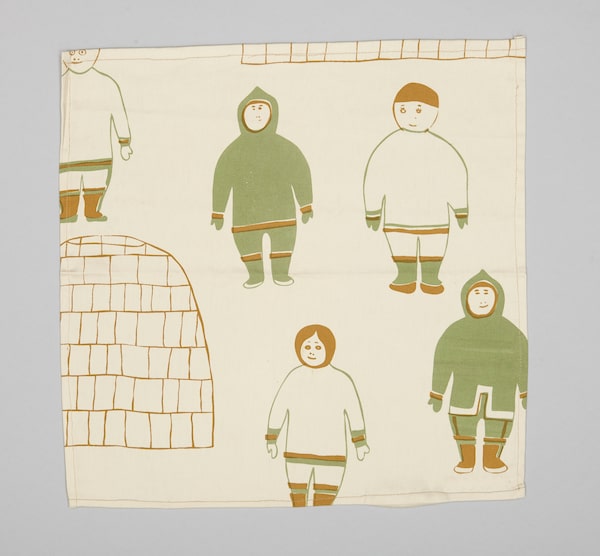
The Printed Textiles from Kinngait Studios installation at the Textile Museum of Canada in Toronto.Darren Rigo
The owl print or the soapstone walrus have become so fixed in the Canadian imagination it may be difficult to consider Inuit art as something other than inevitable. The West Baffin Eskimo Co-operative (as it has been called since its inception) celebrated its 60th year in 2019, and the anniversary programming includes an exhibit devoted to Kenojuak Ashevak that will be touring the country in 2020. That survey includes rare drawings, the artist’s original images of the bears, birds and mystical figures so familiar from the popular prints. But an exhibition of early silkscreened and block-printed textiles from Cape Dorset (or Kinngait) at the Textile Museum of Canada in Toronto tells a less well-known story and forces a reconsideration of how 20th-century Inuit art began.
As the Canadian government forced a people living on the land into permanent settlements, the Inuit began to need cash. The art projects run by the Cape Dorset co-op – the arm that would become Kinngait Studios – were initially introduced by government agents. The idea was that the skills used to carve stone, incise bone and sew clothing could be adapted to produce handicrafts for southern markets. But carving and printmaking were just two possibilities: This show offers a wide selection of rarely seen textiles, startlingly modernist and highly colorful designs created in the 1950s and 60s.

Spirits and Birds, by artist Pudlo Pudlat.Reproduced with the permission of Dorset Fine Arts
The show, curated by Roxane Shaughnessy, includes a small selection of clothing and boots decorated with stitching and appliqué that gave rise to the idea Inuit artists might excel at designing textiles. And then it includes bolt after bolt of the striking fabrics: Before they became prints on paper, drawings by Cape Dorset artists were conceived as potential patterns for interior design or clothing. Just as the prints were not pulled by the artist themselves but by master printmakers using their drawings, the textiles were also printed in the co-op using imagery from drawings. (One of the key printers was Kananginak Pootoogook, who as a young man was instrumental in establishing the co-op and later became well-known for his own imagery.)

Parr's People, by artist Parr.Reproduced with the permission of Dorset Fine Arts./Dorset Fine Arts
So a black drawing of a large goose with a dog and walrus by the artist Parr (who used only one name and is a key figure in the exhibition) becomes a pattern of brown and red geese on cotton sateen twill. Pitseolak Ashoona creates an image of an owl for a stonecut print that shows up again as a repeating figure on a bolt of linen. A photograph of Ashevak shows her wearing a dress with her own images of birds printed down the long, bell-shaped sleeves. Twenty-one artists are represented – most of whom are now dead – but some of the pieces are anonymous: This show is preserving an artistic history as fragile as the textiles themselves.
To contemporary eyes, the bold but simple patterns in strong yellows, pinks, reds and blues echo the familiar imagery of the prints, but also look distinctly modern. Indeed, the show has a powerful mid-century vibe that evokes Mary Quant or Marimekko as much as Ashevak or Pootoogook. The exoticism of these art fabrics made them hip at the time: The show includes a few commercial images of southern models wearing clothes printed with Kinngait imagery posing incongruously in the Arctic.

Camp Scene, by Anna Kingwatsiak.Reproduced with permission by Dorset Fine Arts
One Toronto company does still license the patterns – and there’s a new, bright yellow shirt offered as an example – but for the most part, the textile project foundered on the logistics of trying to produce hand-printed yardage in the North. Prints and carvings proved easier to make and sell.
Still, the current nostalgia for 20th-century design suggests southerners might now embrace Inuit textiles. A handful of contemporary examples speak to some continuity in the tradition. These include a cotton dress designed by Martha Kyak of InukChic with a richly coloured floral pattern on a dark ground and a shape based on the traditional amauti, or women’s parka, with its long tail coat. It’s a striking piece of clothing and more evidence of the complexities of Inuit art history.
Printed Textiles from Kinngait Studios continues through Aug. 30 at the Textile Museum of Canada.
Live your best. We have a daily Life & Arts newsletter, providing you with our latest stories on health, travel, food and culture. Sign up today.
 Kate Taylor
Kate Taylor